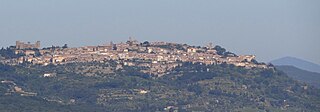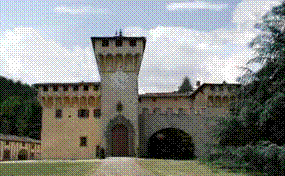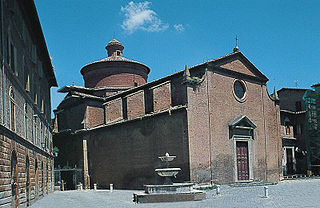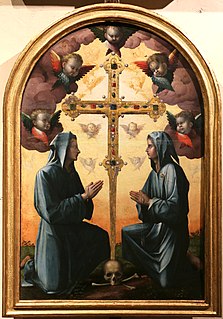
Montalcino is a hill town and comune in the province of Siena, Tuscany, central Italy.

Livorno is a port city on the Ligurian Sea on the western coast of Tuscany, Italy. It is the capital of the Province of Livorno, having a population of 158,493 residents in December 2017. It is traditionally known in English as Leghorn.

Fabriano is a town and comune of Ancona province in the Italian region of the Marche, at 325 metres (1,066 ft) above sea level. It lies in the Esino valley 44 kilometres (27 mi) upstream and southwest of Jesi; and 15 kilometres (9 mi) east-northeast of Fossato di Vico and 36 kilometres (22 mi) east of Gubbio. Its location on the main highway and rail line from Umbria to the Adriatic make it a mid-sized regional center in the Apennines. Fabriano is the headquarters of the giant appliance maker Indesit.

The Villa Farnese, also known as Villa Caprarola, is a pentagonal mansion in the town of Caprarola in the province of Viterbo, Northern Lazio, Italy, approximately 50 kilometres (31 mi) north-west of Rome. This villa should not be confused with the Palazzo Farnese and the Villa Farnesina, both in Rome. A property of the Republic of Italy, Villa Farnese is run by the Polo Museale del Lazio.

Bracciano is a small town in the Italian region of Lazio, 30 kilometres northwest of Rome. The town is famous for its volcanic lake and for a particularly well-preserved medieval castle Castello Orsini-Odescalchi. The lake is widely used for sailing and is popular with tourists; the castle has hosted a number of events, especially weddings of actors and singers.

Baldassare Tommaso Peruzzi was an Italian architect and painter, born in a small town near Siena and died in Rome. He worked for many years with Bramante, Raphael, and later Sangallo during the erection of the new St. Peter's. He returned to his native Siena after the Sack of Rome (1527) where he was employed as architect to the Republic. For the Sienese he built new fortifications for the city and designed a remarkable dam on the Bruna River near Giuncarico. He seems to have moved back to Rome permanently by 1535. He died there the following year and was buried in the Rotunda of the Pantheon, near Raphael.

Illusionistic ceiling painting, which includes the techniques of perspective di sotto in sù and quadratura, is the tradition in Renaissance, Baroque and Rococo art in which trompe-l'œil, perspective tools such as foreshortening, and other spatial effects are used to create the illusion of three-dimensional space on an otherwise two-dimensional or mostly flat ceiling surface above the viewer. It is frequently used to create the illusion of an open sky, such as with the oculus in Andrea Mantegna's Camera degli Sposi, or the illusion of an architectural space such as the cupola, one of Andrea Pozzo's frescoes in Sant'Ignazio, Rome. Illusionistic ceiling painting belongs to the general class of illusionism in art, designed to create accurate representations of reality.

The Villa Medicea di Cafaggiolo is a villa situated near the Tuscan town of Barberino di Mugello in the valley of the River Sieve, some 25 kilometres north of Florence, central Italy. It was one of the oldest and most favoured of the Medici family estates, having been in the possession of the family since the 14th century, when it was owned by Averardo de' Medici. Averardo's son, Giovanni di Bicci de' Medici, is considered to be the founder of the Medici dynasty.

Santo Spirito is a Renaissance style, Roman Catholic church located in piazza Santo Spirito, where Via dei Pispini meets Vicolo del Sasso, in Siena, Italy.

The Church of Santa Maria dei Servi is a Romanesque style, Roman Catholic church in the Terzo of San Martino in the city of Siena, Tuscany, Italy.

Siena is a city in Tuscany, Italy. It is the capital of the province of Siena.

San Sebastiano in Vallepiatta is an ancient church found next to piazzeta della Selva in Siena, Italy. It is located in the Contrada della Selva.

The church of Santi Severino e Sossio and the annexed monastery are located on via Bartolommeo Capasso in Naples, Italy.

Montevitozzo is a village in Tuscany, central Italy, administratively a frazione of the comune of Sorano, province of Grosseto, in the tuff area of southern Maremma. At the time of the 2001 census its population amounted to 106.

Santa Caterina da Siena is a church in Rome dedicated to Catherine of Siena. It is sited on via Giulia in the Regola district.

San Giovannino della Staffa, also known as San Giovannino in Pantaneto is a Renaissance style, Roman Catholic church located on Piazetta Virgilio Grassi, in the Contrada del Leocorno, in the city of Siena, region of Tuscany, Italy.

San Niccolò al Carmine, also called Santa Maria del Carmine is a Renaissance style, Roman Catholic church and monastery located in Pian dei Mantellini #30, near the corner of Via della Diana in the Terzo de Citta of Siena, region of Tuscany, Italy. The church now serves as the Oratory for the Contrada of Pantera. Across the street from the belltower is the Palazzo Celsi Pollini. North along Pian dei Mantellini, toward the Arco delle Due Porte, and on the same side of the street are a number of palaces built around what was once the Monastery of the Derelict Women: in order they are the Neoclassical Palazzo Incontri, the Palazzo Ravissa and the Palazzo Segardi.

The Palazzo Celsi Pollini, once also called the Palazzo del Vescovo, is a Renaissance style urban palace in Siena, Italy. It is located on Pian dei Mantellini #39-41, at the corner with Via San Quirico. A 19th-century source refers to the house as Casa Campioni. The main facade faces the campanile of San Niccolò del Carmine.

The Villa Santa Colomba is a renaissance-style fortress palace structure located in the village of Santa Colomba, a frazione of Monteriggioni, a few miles outside Siena, in the region of Tuscany, Italy.

.





















